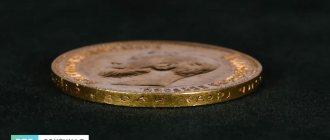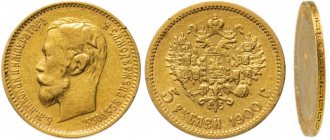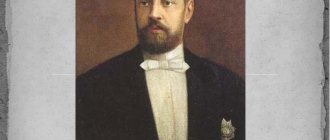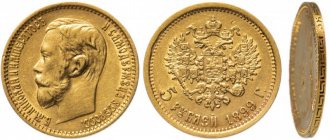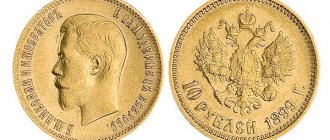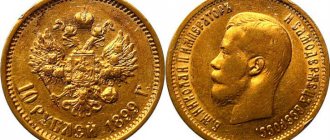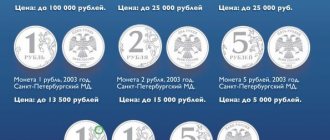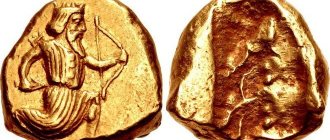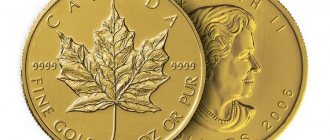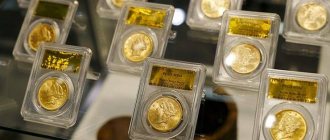During the reign of Nicholas II, a large number of gold coins were issued. These were a variety of denominations, which had their own original design, weight and size. Today, numismatists with great passion try to acquire a collection of such coins at auctions, the price of each of which amounts to several thousand dollars. One of the most honorable places in this collection is rightfully occupied by 10 rubles .
How often are 10 rubles from 1901 counterfeited?
The 10 ruble coin, issued under the last Russian Tsar, is one of the most frequently counterfeited. Immediately after the revolution, the Bolsheviks needed money, and the country was also in debt to European states. Gold coins of the new type were not accepted abroad, so the Bolsheviks decided to use a stamp partially preserved after the revolution. With its help, a fairly large number of counterfeit royal chervonets were issued.
With the development of technology and the emergence of online stores, many Chinese counterfeits have appeared. The banknotes are made with high quality, with a high degree of reliability, but they do not contain gold. In addition, such coins are completely legal, because... are positioned by the seller as replicas in “imitation of antique style.”
History of 10-ruble coins in Russia. Reference
On the 1755 test coin of Empress Elizabeth Petrovna in denomination of 10 rubles, the first official name “golden” appeared. It had the inscription “Elizabeth gold”. Subsequently, the adopted external design remained unchanged for many years (until the reign of Paul I): five cartouches arranged crosswise, with coats of arms (state - in the center, Moscow, Kazan Siberian and Astrakhan - around). In the corners of the cross there are date numbers, and the denomination is indicated by the words “ten rubles”. The coin received the name imperial, which appeared in connection with the declarative inscription “Imperial Russian coin”.
The Imperial was minted from 1755 to 1805 and from 1885 to 1917. The coin of the 1755 model had a face value of 10 rubles and was equivalent to 10 silver rubles. Made from 900/1000 gold, the weight of the coin was 12.9039.
Gold royal coins with a face value of 10 rubles, which were issued in the 19th century, weighed from 8.6 to 12.9 grams (depending on the date of minting).
In Soviet Russia, simultaneously with the release of paper chervonets, in October 1922, a decision was made to issue gold chervonets in the form of coins. In terms of its weight characteristics (8.6 g, 900 standard) and size, the chervonets fully corresponded to the pre-revolutionary 10 ruble coin. The obverse of the coin depicted the coat of arms of the RSFSR; on the reverse is a peasant sower, based on the sculpture of Shadr.
The golden chervonets was intended mainly to pay for foreign trade transactions and was not widely circulated within the country.
The issue of this coin in the USSR returned in 1975, when 250 thousand gold chervonets were minted. And from 1976 to 1982, 1 million pieces were minted annually. In addition, in 1980, for the XXII Olympic Games in Moscow, another 100 thousand pieces of gold chervonets were issued.
Gold coins "Chervonets" issued in 1980 - 1981, are made of high-grade 900 gold, weighing 8.6 grams and with a diameter of 22.6 mm.
Due to the inflation of 1990-1991, coins of lower denominations were not in demand due to the insignificance of their purchasing power. In 1991, an attempt was made to introduce a new type of coins in denominations of 10 and 50 kopecks, as well as 1, 5 and 10 rubles. On the front side of these coins, instead of the coat of arms and the abbreviation “USSR”, fragments of the Moscow Kremlin buildings (the building of the Supreme Soviet of the USSR and the Kremlin towers) and the name of the issuer: “State Bank of the USSR” are depicted. For the first time in the history of Soviet monetary circulation, there is no state emblem on coins. The release of coins of this series into circulation occurred a few days after the signing of the “Belovezhskaya Agreement on the collapse of the USSR.” The new coins were in circulation for about a year. Among numismatists, they were called “GKChP coins.”
In 1992, Russian Federation coins of a new type were issued. On the front side of the coins there was an image of a double-headed eagle, which was the official coat of arms of the Russian Federation (the coat of arms had not yet been approved by the Parliament of the Russian Federation at that time). Also, all coins lack the name of the country.
The 10 ruble coin is made of copper-nickel alloy, diameter 21 mm.
In 1993, due to inflation, coins in denominations of 1 and 5 rubles disappeared. As a result of the new monetary reform, 10 rubles becomes the smallest coin. The 10-ruble coin of the 1993 model is made of copper-nickel alloy, weighing 3.75 g and with a diameter of 21 mm.
In 1995, the State Bank of Russia abandoned the minting of the ruble in coins, expressing it only in bank notes. But already in 1998, during the redenomination of the ruble (changing the denomination of banknotes in order to prepare for the stabilization of monetary circulation), coins appeared in use again.
The Bank of Russia coin with a face value of 10 rubles (combined) of the 1997 sample has a mass of 8.40 g. It is bimetallic, assembled from two metals: the white core is minted from cupronickel, and the yellow outer ring is made from a copper-zinc alloy (brass).
The Central Bank issued 10-ruble coins in a limited edition - they were mainly dedicated to significant and memorable dates, and were often sold out to collectors.
At the end of 2006, the first deputy chairman of the Central Bank of the Russian Federation, Georgy Luntovsky, announced that the Central Bank plans to replace 10-ruble banknotes with coins of the same denomination.
What's worth knowing
Tsar's chervonets were minted between 1898 and 1911 and bore the profile of the last Russian Tsar, Nicholas II. It is interesting that not all domestically produced banknotes bore portraits of reigning emperors and empresses. Thus, under Paul I, a decree was introduced (later repealed) banning the depiction of the Tsar’s face on printed money.
The Tsar's chervonets had the profile of Nicholas II.
Chervonets were produced by the St. Petersburg Mint, whose mintsmeisters (chiefs) at that time were Felix Zaleman (1899 - 1901) and Alexander Redko (1901 - 1905). Their initials were engraved on the edge of the coin.
Original coins are characterized by a deeper imprint of “1” in the year of issue, because the machine displayed the year with great effort on one, and not on other numbers.
How many coins were issued at court?
Statistical data on the amount of money issued are given for the period for 1901.
| Copper | Circulation |
| 1 kopeck | 30 million coins |
| 2 kopecks | 20 million coins |
| 3 kopecks | 10 million coins |
| Silver | Circulation |
| 5 kopecks | 5.8 million coins |
| 10 kopecks | 15 million coins |
| 15 kopecks | 6.7 million coins |
| 25 kopecks | There are no exact numbers, but the batch was small |
| 50 kopecks | 412 thousand coins |
| Gold | Circulation |
| 5 rubles | 7.5 million coins |
| 10 rubles | 2.4 million coins |
How are counterfeits made?
The Russian counterfeit market produces fakes by casting a circle from metal. A stamp copied from genuine banknotes subsequently leaves a mark on it. For authenticity, money is made from the same metal as the original, but the desire for the greatest similarity leads to the fact that there is more gold in the fake than in the Nicholas Chervonets.
Counterfeit coins were cast from metal.
Which catalogs can be used to determine the value of old gold coins?
While searching on the Internet, you will come across numerous catalogs with prices of old royal coins. But these prices are very different, and it becomes unclear which of them to take as a basis. First of all, you will need prices from auctions. Many catalogs have summary tables for each coin, showing all of its auction yields. They specifically indicate the name of the auction, the sale price, the safety of the coin, the date of the event and any other data. Using this information, you can get a rough idea of whether the coin will cost thousands, tens, hundreds of thousands or millions of rubles. When analyzing data, keep in mind the price levels in specific years, especially in years with significant inflation. An expert will give you a more accurate estimate of the coin’s value, taking into account its rarity, state of preservation and other indicators, after an examination.
In addition, many catalogs themselves indicate the approximate value of a particular coin based on auction sales, expert opinions and the degree of preservation of the coin. This information on different sites is quite different for the same coins, but can also serve as a guide for determining the approximate price of the coin.
Another type of price that is often listed in catalogs is the purchase price. This parameter shows at what price the site owner is willing to buy a coin from you. If you need a profit in a short time, then this option may be suitable for you, but it will not give you the same profit that you can get, for example, from a successful auction.
Methods for determining the authenticity of a ten-ruble coin of 1901
Nowadays, interest in numismatics has increased greatly, which has led to a flood of the market with copies of royal (and other) coins. Now the offer to purchase rare banknotes and add to your collection can be heard not only at auctions, but also at the market or in a shopping center. To avoid becoming a victim of scammers, you need to know how to distinguish completely clumsy fakes. To make a fake chervonets of higher quality, you cannot do without an examination.
Tooth test
A method familiar to everyone from movies and books with pirates: bite a coin, and if it is original, a mark will remain. You can try, but there are a number of disadvantages:
- money is minted not only from hard alloys, for example, on lead the mark will remain the same as on gold;
- tooth enamel may be damaged;
- the seller may not understand: if everyone bites rubles, there will be little left of them;
- not hygienic.
A tooth sample does not guarantee authenticity.
In addition to the above disadvantages, this method does not provide a complete guarantee of authenticity.
Special ringing
The essence of the test is to toss a chervonets. When it falls on a hard surface, listen to the sound.
For such an experiment to be successful, you need to have excellent hearing and know what kind of ringing the original coin makes. You can take a genuine banknote and one that is in doubt, throw it in, and compare it. But few people will agree to such an experiment, during which confusion may occur.
Different materials make different sounds when struck. But will your ear hear it?
It makes sense to conduct the experiment under ideal conditions, throwing two coins (the test one and the authentic one) onto the same surface.
It is advisable that the study be blind and the thrower does not know which coin he wants to determine the authenticity of. Creating the conditions for such an experience during the buying process is not easy.
Where do they sell and buy coins?
Ancient banknotes made of gold have not only historical, but also financial value. Nowadays, many people are into collecting, but for beginners or people who decide to simply sell an existing antique banknote, you need to know that the first thing you need to do is assess their condition.
There are a huge number of catalogs, with the help of which you can familiarize yourself with the specimens indicated in it, read the description, and choose the coin you like.
You can buy and sell royal gold chervonets and other ancient money at auctions, as well as by contacting private collectors. Quite a few examples are sold at the actual cost of a gram of gold, but there are types that have a very high value due to their rarity.
Comparison of fake and original 10 rubles 1901
It’s worth starting to compare from the basics, i.e. from the metal from which the coin is made. The original was minted from 900-karat gold, but a high-quality copy is most often made from a real alloy. The only slight difference will be in weight and size.
The reverse of the chervonets is made accurately with great detail, especially the double-headed eagle. Fakes suffer from less precision in detail and blurred boundaries.
The obverse contains the face of the autocrat, similar to the portrait image of those years; it is harmonious and proportional. In a fake, Nicholas II does not always look like himself and is printed sloppily, the print looks careless. Many “coin producers” forget about the dot in the inscription on the right side of the portrait “AND THE AUTOCRET OF ALL RUSSIA.”
The edge is the most problematic side for counterfeiting. Therefore, the inscription is either replaced by an imitation of signs or is completely absent. If the fake is of high quality, then you should carefully study the inscription and initials of the mint master.
Degree of safety of coins
For collectors, when purchasing a medallion, an important role is played not only by the year of its issue, but also by the degree of preservation. When a coin is assessed by professionals, its quality, condition, and appearance affect its value and value. If a common banknote is in perfect condition and has a high degree of preservation, it can be sold at a fairly high price than a rare copy with a high degree of wear.
Assessing the condition of banknotes is a complex process. The gold from which the lot is made must be of the required standard, the design must be clearly visible, and the coin must not have mechanical damage. There should also be no stains or other factors that reduce the price.
There are special world standards according to which the condition of each specimen is determined and which guide collectors and appraisers. Often in the line where the quality of gold ten-ruble notes is stated, you can see the word “proof”. This term has nothing to do with quality, but refers to the method of manufacture and means trial minting. It occurred during the development and approval of a new coin stamp.
There is the following system for classifying the condition of medallions:
- BU (Brilliant Uncirculated) - means the highest degree of preservation, if the coin has not been in circulation at all.
- Uncirculated means perfect condition.
- AU (About Uncirculated). The condition is a little less than ideal.
- XF (Extremely Fine). Medallions that were in use for a short time.
- VF (Very Fine) means very well preserved.
- F (Fine) indicates good condition.
- VG (Very Good) – satisfactory condition.
- G (Good). This designation indicates poor preservation.
Where and how to sell gold coins of Tsarist Russia
You can sell coins of Tsarist Russia either directly to the end consumer or to resellers. Resellers include pawnshops, antique shops, numismatic sites or private individuals making purchases. Since they buy with the goal of reselling at a profit, their price will always be much lower than what you would receive in a direct transaction. But this method will be useful if you want to quickly make a profit. The transaction itself is usually carried out under the following conditions: you send a photo, an expert uses it to evaluate the coins and name the amount that you can be paid. If you agree, you come to the office with coins or send them by mail and receive money.
The end consumers are most often collectors who live in numismatic clubs, communicate on forums or attend any private events. It is also possible to sell directly to collectors at auctions, and this method is considered the most profitable. At auctions, you will have to pay a commission to the organizer, but the transaction amount can be many times higher than expected if there are many willing to compete for valuable items. If you have particularly valuable coins, check with several auction houses as they offer favorable terms for larger transactions. If you are a representative of an organization, we invite you to organize an auction on our site.
Whichever sales method you choose, it’s best to start with small sales so that you can practice the nuances of each option. Also, be careful, as fraud is rampant in coin transactions: they may give you a counterfeit, not pay you, or even try to rob you of your expensive collection.
Where and how to buy gold coins of Tsarist Russia
Since the royal coins, despite their considerable age, have reached us in great variety, they are sold in a variety of places, from antique shops to websites. Therefore, first of all, decide on the goals of the collection (replenishment of the collection, investment, gift to an antiques connoisseur, etc.) and the budget that you are willing to spend. This is necessary due to the fact that some especially rare specimens cost millions of rubles. At the same time, there are many coins in an affordable price category in the region of several hundred or thousand rubles apiece.
Quite popular places where you can find a rare coin are online stores and sites with private advertisements. There are interesting offers in numismatic online clubs, on forums and in other numismatist communities. The trading rules on each such site are different and require certain communication and transaction skills. Since the assortment here is varied, the problem is not so much in finding the right coin, but in finding a reliable seller. This is especially true for message boards of private individuals, and even popular sites are inhabited by scammers. Therefore, when purchasing, pay attention to the reputation of the seller, the number of his transactions and study whether the site has any methods of protection against fraud.
Sometimes coins are sold right on the street with words like: “I was rummaging through my grandmother’s trash and found old coins, but I don’t understand it, maybe they are valuable.” Novice collectors often fall for this trick and give the attacker several thousand rubles, believing that they are being unknowingly sold a coin of great value. But in the end it turns out that the coin is a fake and not worth the money spent.
Another popular place to sell is online auctions and auction houses. Many of them are serious organizations in terms of selling originals and conduct examinations of coins and issue expert opinions. If you are a gambling person, try yourself in this direction by first studying the rules of each auction site.
